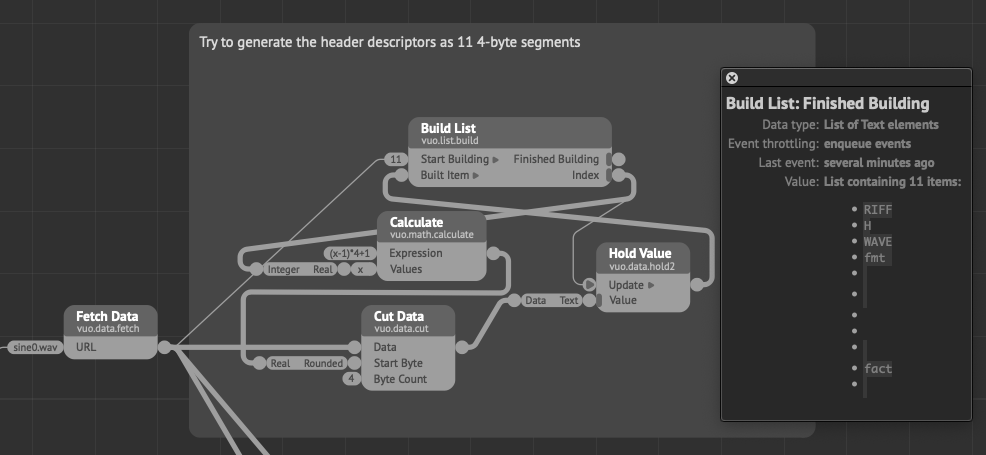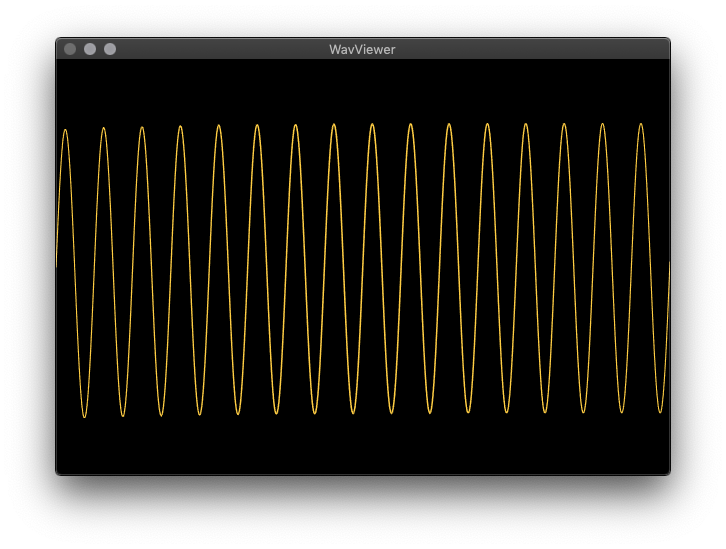Ok – success if I convert the 32-bit float .wav to 16-bit integer. Attached zip file includes comp, updated subcomps and .wav files.
Here’s what I did to get things working. First thing was to set up some fresh analysis using Terminal:
https://wiki.lazarus.freepascal.org/macOS_Sound_Utilities
Used afinfo on my 32-bit float file:
File type ID: WAVE
Num Tracks: 1
----
Data format: 1 ch, 44100 Hz, 'lpcm' (0x00000009) 32-bit little-endian float
no channel layout.
estimated duration: 0.743039 sec
audio bytes: 131072
audio packets: 32768
bit rate: 1411200 bits per second
packet size upper bound: 4
maximum packet size: 4
audio data file offset: 80
optimized
source bit depth: F32
----
Then used Terminal afconvert -f WAVE -d LEI16 to convert it to a 16-bit .wav file. (Just cuz already in terminal and learning these new tools – assuming could have used any audio software to convert. EDIT: WRONG assumption, see below – Audacity export is different.)
New file info:
File type ID: WAVE
Num Tracks: 1
----
Data format: 1 ch, 44100 Hz, 'lpcm' (0x0000000C) 16-bit little-endian signed integer
no channel layout.
estimated duration: 0.743039 sec
audio bytes: 65536
audio packets: 32768
bit rate: 705600 bits per second
packet size upper bound: 2
maximum packet size: 2
audio data file offset: 4096
optimized
source bit depth: I16
----
Important clue:
audio data file offset: 4096
Essentially this offset value helped solve the issue. I wish I could extract it in Vuo. The number 4096 here apparently relates to the Apple ‘FLLR’ subchunk – listed in the Read Wave Header subcomp “File info” readout – which designates (IIUC) >4k bytes before the audio data “payload” starts.
So I try offsetting the data start byte to 4097 – works. I also noticed in the Read Wave Header “File info” readout that the “Sub-chunk 2 size” reads 4044 – related but 52 bytes off – 44 byte header + 8 bytes? So I tried setting the data start byte to 4045 and that also works. So i am a little confused why both work, still a lot I’m not getting about the numbers… (Btw, also had to rejigger the Read Wave Header subcomp to properly calculate the data section size, took a minute to get that sorted.)
Finally – success!!!
Part 2: tried a simple conversion from Audacity, since the export to .wav only exports 16-bit. (I set up a macro – now I can easily batch convert my 32-bit files to 16-bit). Terminal afinfo shows that it is different from the .wav using Apple’s afconvert, the Audacity file is presumably more “universal” (i.e., audacity does not add the “FLLR” chunk and the +4k byte padding – why oh why would Apple do that…).
And using the data file offset to set the data start byte (to 45) works:
File type ID: WAVE
Num Tracks: 1
----
Data format: 1 ch, 44100 Hz, 'lpcm' (0x0000000C) 16-bit little-endian signed integer
no channel layout.
estimated duration: 0.743039 sec
audio bytes: 65536
audio packets: 32768
bit rate: 705600 bits per second
packet size upper bound: 2
maximum packet size: 2
audio data file offset: 44
optimized
source bit depth: I16
----
Yet another doc has proved helpful in all this RIFF stuff: Google Code Archive - Long-term storage for Google Code Project Hosting. (which originated here: python - AVAudioRecorder doesn't write out proper WAV File Header - Stack Overflow ).
Notable:
Reading WAVE files properly must really begin as an exercise in locating and identifying RIFF subchunks.
And:
It is allowable to insert subchunks after the data payload.
Which gets back to @smokris’s point not to trust where chunks are. Case in point, learned today that “acidized” .wav’s – a common format for adding loop metadata readable by audio sampler synths – put their loop metadata after the audio data “payload”.
Finally…
@MartinusMagneson wrote:
If you’re not scared of some heavy nerding, you can also just get the bytes from the wav files via the Data nodes and convert the sample range from the file to the Y-values you need. That way you get straight to the data you want …
: : Well, I guess I’m learning a few things. :-0
: Well, I guess I’m learning a few things. :-0
(Ps. is drag/drop broken for adding new files to posts?)
3DAudioWaveform.zip (218 KB)



